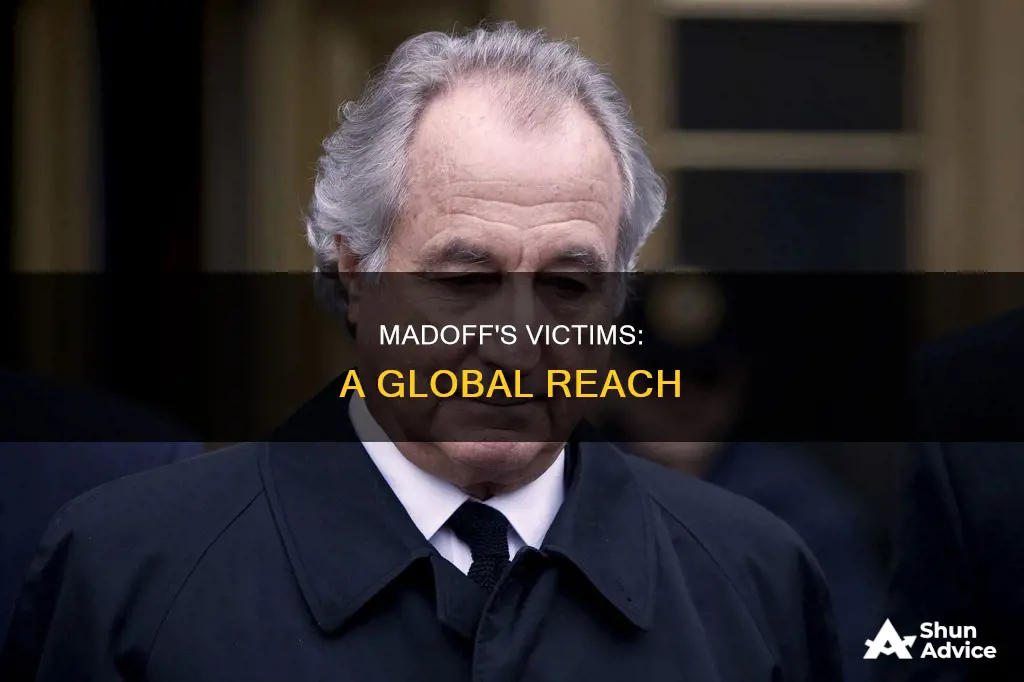
Bernard Madoff's Ponzi scheme defrauded an estimated 37,000 people in 136 countries, amounting to a loss of \$65 billion in fabricated gains. The scheme, which ran for at least 17 years, targeted wealthy investors, charities, and celebrities, with about 10% of the money coming from nonprofit organizations. The victims' losses are being recouped from fake profits paid out to some Madoff clients, with over $13 billion recovered so far.
| Characteristics | Values |
|---|---|
| Number of investors | 37,000 |
| Number of countries involved | 136 |
| Amount missing from client accounts | 65 billion |
| Estimated losses to investors | $17.5 billion |
| Amount recovered by Irving Picard | $13.3 billion |
| Amount returned to customers by Irving Picard | $12 billion |
| Amount paid out by the Department of Justice | $2 billion |
| Amount paid out by the Madoff Victim Fund | $4 billion |
| Number of victims compensated by the Madoff Victim Fund | 40,000 |
What You'll Learn
- Bernard Madoff's Ponzi scheme defrauded investors of an estimated $65 billion
- Madoff's scheme ran for at least 17 years, with some sources saying it began in the 1970s
- The scheme's collapse in 2008 affected about 4,800 client accounts
- As of 2022, around $4 billion had been returned to 40,000 victims
- The scandal led to prolonged legal battles, with some investors forced to pay back billions

Bernard Madoff's Ponzi scheme defrauded investors of an estimated $65 billion
Bernard Madoff, an American financier, carried out the largest Ponzi scheme in history, defrauding investors of an estimated $65 billion over at least 17 years. The scheme, which ran for decades, targeted thousands of investors, including banks, pension funds, charities, celebrities, and individuals, who lost billions of dollars.
Madoff lured investors by creating an image of respectability and exclusivity, claiming to generate large, steady returns using legitimate investment strategies. He deposited client funds into a single account, which he used to pay existing clients who wanted to cash out, funding the payouts with new capital from investors. This classic Ponzi scheme model maintained the appearance of outsized gains, but inevitably unravelled when too many clients sought to withdraw their money during the 2008 financial crisis.
The impact of Madoff's fraud was widespread, with investors losing their life savings and nonprofits, including charities, among his victims. The scheme also had a significant personal toll, with Madoff's sons, who worked for him, facing legal and personal repercussions. His elder son committed suicide two years after the fraud was exposed, and his younger son died of cancer in 2014.
In the aftermath of the scheme's collapse, trustees and lawyers have worked to recoup losses and return money to victims, recovering billions of dollars through lawsuits, settlements, and forfeiture actions. The complex and lengthy process of unwinding the fraud has involved controversial decisions and set precedents for future scandals.
Madoff, who died in prison in 2021 at the age of 82, pleaded guilty to 11 federal felonies and was sentenced to 150 years in prison for his role in the scheme. His massive fraud has left a lasting impact, serving as a cautionary tale and highlighting the need for improved investor protections and rigorous investigations by regulatory bodies.
Why Private Equity is Worth the Risk
You may want to see also

Madoff's scheme ran for at least 17 years, with some sources saying it began in the 1970s
Bernie Madoff's Ponzi scheme, which defrauded thousands of investors out of an estimated $65 billion, ran for at least 17 years, with some sources saying it began in the 1970s. The scheme was exposed in late 2008, but it is unclear exactly when it started.
Madoff himself testified in court that his fraudulent activities began in the early 1990s. However, his account manager, Frank DiPascali, who had been working at the firm since 1975, said the fraud had been occurring "for as long as I remember". Federal investigators believe the scheme may have started in the 1970s, while Madoff's brother Peter claimed it began in the 1980s.
Madoff's Ponzi scheme was a massive fraud, in which he collected money from clients and used it to pay those who wanted to liquidate their holdings. He marketed this as a legitimate investment strategy called the "collar" or "split-strike conversion", which involved purchasing blue-chip stocks and taking options contracts on them. This allowed him to conceal his scam, avoid scrutiny, and provide an explanation for his consistent returns.
The scheme unravelled when the global financial crisis of 2008 led to a wave of redemption requests from investors. Madoff was unable to cover these requests, as he had been using new investors' money to pay existing clients. Despite receiving financial backing from friends, he could not obtain the funding needed to meet the redemption requests.
Madoff was arrested in December 2008 and later sentenced to 150 years in prison. He died in prison in 2021 at the age of 82.
Safemoon Investors: Who's In?
You may want to see also

The scheme's collapse in 2008 affected about 4,800 client accounts
The 2008 collapse of Bernard Madoff's investment advisory firm affected about 4,800 client accounts, but the scheme's impact extended far beyond these immediate victims. The fallout from the fraud, which totalled almost $65 billion, reverberated through the lives of thousands of people, including charities, celebrities, and investors worldwide.
Madoff's scheme, which was the largest Ponzi scheme in history, involved depositing client funds into a single bank account and using those funds to pay existing clients who wanted to cash out. This created the illusion of large, steady returns and attracted new investors. However, when the 2008 financial crisis hit and too many clients sought to withdraw their money, the fraud unravelled.
The collapse of Madoff's scheme had devastating consequences for its victims. People lost their life savings, nonprofits saw their funds decimated, and some investors were forced to pay back billions in ill-gotten gains. The fallout from the scheme was so widespread that it sparked debates about investor protections and raised questions about the effectiveness of regulatory bodies like the Securities and Exchange Commission (SEC).
In the years following the collapse, Irving Picard, the trustee appointed to oversee the liquidation of Madoff's firm, worked tirelessly to recover funds for the victims. By 2018, Picard had recovered $13.3 billion, or about 70% of approved claims. This recovery rate was considered extraordinary for a fraud of this magnitude, and Picard's efforts provided some measure of relief to those affected by the scheme.
The collapse of Madoff's scheme in 2008 not only affected the 4,800 client accounts directly invested with him but also had far-reaching consequences, impacting thousands of people and sparking ongoing discussions about investor protections and regulatory effectiveness.
Why Invest in Farms?
You may want to see also

As of 2022, around $4 billion had been returned to 40,000 victims
Bernard Madoff, an American financier, carried out the largest Ponzi scheme in history, defrauding investors of an estimated $65 billion over at least 17 years. He was also a pioneer in electronic trading and chairman of the Nasdaq stock exchange in the early 1990s.
Madoff's scheme, which ran for decades, defrauded thousands of investors out of tens of billions of dollars. He created a front of respectability, claiming to use a legitimate strategy, and his returns were high but not outlandish.
Madoff was sentenced to 150 years in prison and ordered to forfeit $170 billion in 2009. He died in a federal correctional facility in April 2021 at the age of 82.
As of late September 2022, about $4 billion had been returned to 40,000 of his victims via the U.S. Department of Justice's Madoff Victim Fund. This fund was established to compensate investors who did not invest directly with Madoff but through feeder funds or money managers.
The process of returning money to victims has been complex and lengthy. Irving Picard, the trustee appointed by a federal bankruptcy court to liquidate the Madoff firm and return assets to investors, has recovered more than $13.3 billion, which amounts to 76% of the $17.5 billion in principal lost in the scam. This does not include the separate $4 billion fund established by the Department of Justice.
In addition to the government's efforts, some early investors and financial firms that profited from the scheme have been forced to return their gains to compensate victims. The single biggest beneficiary, investor and philanthropist Jeffry Picower, withdrew $7.2 billion from Madoff Securities before the scheme collapsed. After Picower's death in 2009, his widow agreed to hand over this money to the U.S. government to help repay Madoff's victims.
The outcomes for Madoff's victims have varied widely. Some have received payments totalling about 60% of their investment, while others have not received anything. The formula for distributing recoveries to victims has been controversial, as it focuses on suing customers who withdrew more money than they put in, rather than compensating all those who lost money.
Millionaires' Investment Strategies
You may want to see also

The scandal led to prolonged legal battles, with some investors forced to pay back billions
The Bernard Madoff investment scandal, the largest Ponzi scheme in history, defrauded investors of an estimated $65 billion, including fabricated gains. The scandal led to prolonged legal battles, with some investors forced to pay back billions.
Madoff, an American financier, was arrested on December 11, 2008, and later sentenced to 150 years in prison for running the Ponzi scheme. The scheme, which ran for at least 17 years, involved depositing client funds into a single bank account and using those funds to pay existing clients who wanted to cash out. New investors' capital was used to fund the redemptions, keeping the fraud going.
The collapse of his company affected about 4,800 client accounts and sparked legal battles over the remaining funds. The court-appointed trustee, Irving Picard, has focused on suing customers who withdrew more than they invested to recover cash deposits for victims. This strategy has been controversial but was ultimately approved by the courts. So far, Picard has recovered about $13.3 billion, or 70% of approved claims.
Some investors have been forced to return billions of dollars in ill-gotten gains. These include early investors and financial firms that cashed out of Madoff's funds before the scheme collapsed. The largest beneficiary, investor and philanthropist Jeffry Picower, withdrew $7.2 billion from Madoff's firm before his accidental drowning in 2009. Picower's widow agreed to return the full amount to the US government to compensate Madoff's victims.
Another investor, Carl Shapiro, one of Madoff's oldest friends and earliest investors, agreed to pay $675 million, including $38 million repaid by his son-in-law, to be returned to Madoff's victims.
The legal battles also involved investors who had withdrawn funds and were asked to return them. These "net winners" argued that they should have been protected by the Securities Investor Protection Corp. (SIPC), an industry-funded organisation that guarantees customers' securities and cash up to certain limits. However, the courts ruled that the SIPC's guarantee did not cover Madoff's fraud, where no securities were purchased.
Unveiling Rare Investing Opportunities
You may want to see also
Frequently asked questions
It is estimated that as many as 37,000 people in 136 countries invested with Madoff.
The amount missing from client accounts, over two-thirds of which were fabricated gains, was almost 65 billion. The court-appointed trustee Irving Picard estimated actual losses to investors at 18 billion, and much of that money has been returned.
No, a number of early investors and financial firms cashed out of Madoff's funds over the years, allowing them to walk away with billions of dollars.
Bernie Madoff died in a prison hospital at the age of 82 on April 14, 2021, while serving a 150-year sentence for money laundering, securities fraud, and several other felonies.







